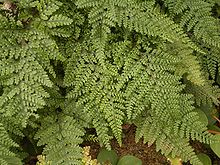- Davalliaceae
-
Davalliaceae 
Davallia bullata Scientific classification Kingdom: Plantae Division: Monilophytes Class: Polypodiopsida Order: Polypodiales (unranked): Eupolypods I Family: Davalliaceae
M.R. SchomburgkGenera - Araiostegiella
- Davallia
- Davallodes
- Humata
- Wibelia
Davalliaceae is a family of ferns in the order Polypodiales. It is sister to the largest family of ferns, Polypodiaceae,[1] and shares some morphological characters with it. [2]
Davalliaceae is native to tropical and subtropical regions of the Pacific, Australia, Asia, and Africa.[3] They are small to medium in size. In the wild, they are usually epiphytic, sometimes epipetric or terrestrial.
Many species of Davallia are in cultivation,[4] with Davallia tyermanii, Davallia fejeensis, and Davallia solida being perhaps the most well-known.[5] A key to the cultivated species of Davallia is available.[6] Davallodes, Humata, and Wibelia have species in cultivation as well.[7]
In Davalliaceae, many of the species are closely related and hard to distinguish from each other. In 1990, a treatment of Davalliaceae estimated the number of species at 110.[2] A 2008 paper listed all of the species, recognizing only 63.[8] A new species, Davallia napoensis was described in 2011.[9]
Contents
Genera
- Araiostegiella M.Kato & Tsutsumi
- Davallia James Edward Smith
- Davallodes E.B. Copeland
- Humata A.J. Cavanilles
- Wibelia Bernhardi
Description
Usually epiphytic or epipetric. Rhizomes dictyostelic, dorsiventral, densely scaly. Stipes articulate at base. Phyllopodia short. veins free. Sporangium stalk 3-rowed. Annulus vertical. Spores monolete.
History
Gymnogrammitis and Leucostegia were once included in Davalliaceae, but these are now known to belong elsewhere. Gymnogrammitis is in a clade with Selliguea and others in the family Polypodiaceae.[10] Leucostegia is in the family Hypodematiaceae,[8] which consists of Hypodematium and Leucostegia,[11] and possibly Didymochlaena as well.[1]
In 2008, a molecular phylogenetic study of Davalliaceae showed that none of the polyspecific genera recognized at that time were monophyletic.[12] In that same year, a revision of the family divided it into five genera.[8] One of these, Araiostegiella, was newly described. The genus Davallia was divided into two sections, named Davallia and Trogostolon.
The monotypic genera Trogostolon and Parasorus have not been sampled for DNA. Anatomical studies indicate that Trogostolon, along with several species of Davallia, belongs in Davallia section Trogostolon. Likewise, Parasorus seems to belong to one of the two clades that constitute the genus Humata.[8] The genus Pachypleuria included nearly all of the species that are now in Humata. It was found to be paraphyletic over the type species of Humata, and is no longer recognized.
Davallodes, Paradavallodes, and Araiostegia are very closely related and their circumscriptions have varied greatly from one author to another. In 2008, Davallodes was expanded to include all of Paradavallodes, and all but three species of Araiostegia. Because the type species of Araiostegia had been transferred to Davallodes, these three species were given a new generic name, Araiostegiella.
The genus Wibelia contains eight species, and was resurrected from Davallia, which it closely resembles.
Phylogeny
The following phylogenetic tree is based on one that was published in 2008.[12]
DAVALLIACEAE Davallodes
Wibelia
Araiostegiella
Humata
References
- ^ a b Eric Schuettpelz and Kathleen M. Pryer. 2007. "Fern phylogeny inferred from 400 leptosporangiate species and 3 plastid genes". Taxon 56(4):1037-1050.
- ^ a b Karl U. Kramer. 1990. "Davalliaceae". pages 74-80. In: Klaus Kubitzki (general editor); Karl U. Kramer and Peter S. Green (volume editors) The Families and Genera of Vascular Plants volume I. Springer-Verlag: Berlin;Heidelberg, Germany. ISBN 978-0-387-51794-0
- ^ Alan R. Smith, Kathleen M. Pryer, Eric Schuettpelz, Petra Korall, Harald Schneider, and Paul G. Wolf. 2008. "Davalliaceae". pages 443-444. In: "Fern Classification". pages 417-467. In: Tom A. Ranker and Christopher H. Haufler (editors). Biology and Evolution of Ferns and Lycophytes. Cambridge University Press. ISBN 978-0-521-87411-3
- ^ Anthony Huxley, Mark Griffiths, and Margot Levy (1992). The New Royal Horticultural Society Dictionary of Gardening. The Macmillan Press,Limited: London. The Stockton Press: New York. ISBN 978-0-333-47494-5 (set).
- ^ George W. Staples and Derral R. Herbst. 2005. "A Tropical Garden Flora" Bishop Museum Press: Honolulu, HI, USA. ISBN 978-1-58178-039-0
- ^ Barbara Joe Hoshizaki. 1981. "The fern genus Davallia in cultivation". Baileya 21(1):1-42.
- ^ Barbara Joe Hoshizaki. 1981. "Davallia relatives in cultivation". Baileya 21(1):43-50.
- ^ a b c d Masahiro Kato and Chie Tsutsumi. 2008. "Generic Classification of Davalliaceae". Acta Phytotaxonomica et Geobotanica 59(1):1-14.
- ^ Fa-Guo Wang, Hong-Feng Chen, and Fu-Wu Xing. 2011. "Davallia napoensis, a New Species of Davalliaceae from Guangxi, China". Novon 21(3):380-384. doi:10.3417/2009093
- ^ Harald Schneider, Alan R. Smith, Raymond Cranfill, Christopher H. Haufler, Tom A. Ranker, and Terri J. Hildebrand. 2002. "Gymnogrammitis dareiformis is a polygrammoid fern (Polypodiacee) - Resolving an apparent conflict between morphological and molecular data". Plant Systematics and Evolution 234(1-4):121-136. doi:10.1007/s00606-002-0207-z
- ^ Hong-Mei Liu, Xian-Chun Zhang, Wei Wang, Yin-Long Qiu, and Zhi-Duan Chen. 2007. "Molecular Phylogeny of the Fern Family Dryopteridaceae inferred from Chloroplast rbcL and atpB Genes". International Journal of Plant Sciences 168(9):1311-1323. doi:10.1086/521710
- ^ a b Chie Tsutsumi, Xian-Chun Zhang, and Masahiro Kato. 2008. "Molecular Phylogeny of Davalliaceae and Implications for Generic Classification". Systematic Botany 33(1):44-48.
External links
Categories:- Davalliaceae
- Polypodiales
- Pteridophyta families
- Epiphytes
Wikimedia Foundation. 2010.
